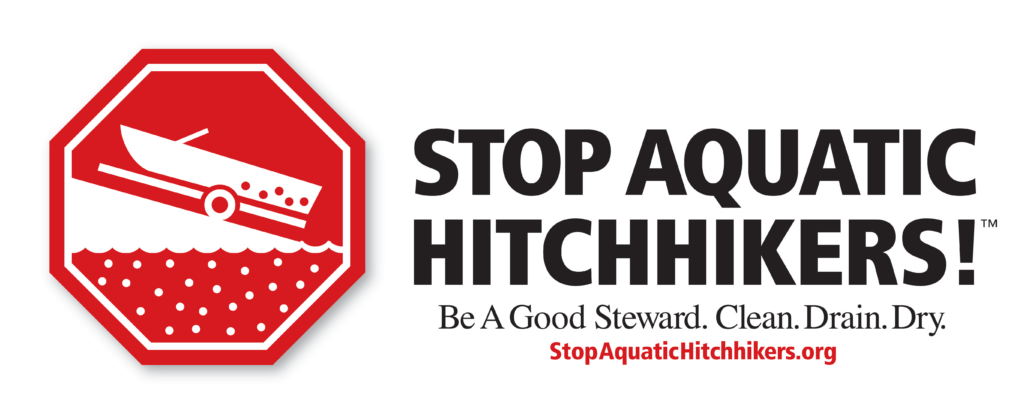Several unwelcome aquatic invasive species have made their way into New Jersey waters and many more are knocking at the door. Aquatic invasive plants like Spiked Milfoil, Hydrilla, and Water Chestnut choke once thriving waterways. Invasive fish species such as Northern Snakeheads, Flathead Catfish, and Swamp Eel can outcompete other fish, including rare native species and prized recreational fish, for food and available habitat. Zebra Mussels choke intake pipes and cover critical spawning substrate. Many of the same mechanisms which transport invasive plants and animals also transmit diseases such as Viral Hemorrhagic Septicemia (VHS), Infectious Pancreatic Necrosis Virus (IPN) and Largemouth Bass Virus (LMBV) which threaten fish populations.
Why are invasive species a problem?
Invasive species are defined as “a species that is non-native to an ecosystem and whose introduction causes or is likely to cause economic or environmental harm or harm to human health.”
- Predation: Large Snakeheads, Blue Catfish and Flatheads indiscriminately consume any fish species small enough to fit into their enormous mouths.
- Competition: Food, spawning areas and habitat are sought by invasive fish, leaving less available for desirable species.
- Habitat Loss: Plants like Hydrilla and Curly-leaf Pondweed can take over a waterway making it less suitable for native wildlife and potentially causing water quality issues.
- Loss of recreation: Snakeheads outcompete native species and negatively impact recreational fisheries. Clinging Jellyfish, a small but venomous species, can deliver painful stings, which can make marine waterways unsafe for summer recreation.
- Decreased Property Value: Beautiful lakefront property can be transformed into a weed-choked monoculture once Spiked Milfoil or Water Chestnut become established.
- Economic Impact: Zebra Mussels cause millions of dollars of damage each year in the Great Lakes alone.
Invasive Fish Species
New Jersey Fish Code statute N.J.A.C. 7:25-6.1(g) prohibits the possession or release of live potentially dangerous animals including fish. Statute N.J.A.C. 7:25-6.2 identifies thirteen species that have been designated as “Potentially Dangerous Species”, with one additional (Freshwater Drum) proposed to be added in 2026. These fish have the potential for becoming a significant threat to indigenous animals, the environment, or public safety. Possession and/or release of these fish species is prohibited and if encountered while angling, they must be destroyed.
Ten of the thirteen species have already been found in New Jersey. Species such as the Northern Snakehead and Flathead Catfish are well established in the Delaware River watershed and threaten to expand outside of the region. The Blue Catfish, currently localized to the Delaware River, is an emerging threat that could have significant negative impacts on native and recreationally important fisheries as the population grows and expands.
Lionfish are not listed in the Freshwater Fish Code, however they pose a significant threat to marine life. They lack predators due to their vibrant coloration and patterns, allowing them to feed on native species with no threat to themselves. A sting from their venomous spines can be painful but is not fatal to humans. While they are still a rare sight to see in New Jersey, it is important to be vigilant.
Although common carp are considered an invasive species by most, they are not designated as one of NJ’s potentially dangerous fish species, in part because of how widespread they have become. The stocking of common carp is prohibited in an effort to minimize their establishment into new waters.
| Common Name | Scientific Name | Freshwater/Marine | Status | |
|---|---|---|---|---|
Fish | Bighead Carp | Hypophthalmichthys nobilis | Freshwater | Emerging |
| Blue Catfish | Ictalurus furcatus | Freshwater | Emerging | |
| Brook Stickleback | Culaea inconstans | Freshwater | Buffer | |
| Flathead Catfish | Pylodictis olivaris | Freshwater | Emerging | |
| Freshwater Drum | Aplodinotus grunniens | Freshwater | Emerging | |
| Grass Carp (diploid) | Ctenopharyngodon idella | Freshwater | Widespread | |
| Green Sunfish | Lepomis cyanellus | Freshwater | Widespread | |
| Lionfish | Pterois volitans | Marine | Buffer | |
| Northern Snakehead | Channa Argus | Freshwater | Established | |
| Oriental Weatherfish (Pond Loach) | Misgurnus anguillicaudatus | Freshwater | Emerging | |
| Round Goby | Neogobius melanostomus | Freshwater, Brackish | Buffer | |
| Silver Carp | Hypoththalmichtys molitrix | Freshwater | Buffer | |
| Swamp Eel | Monopterus albus | Freshwater | Emerging | |
| Warmouth | Lepomis gulosus | Freshwater | Emerging |
Status Key:
- “Watch” – AIS currently present outside eastern North America but has a known introduction pathway to New Jersey
- “Buffer” – AIS within Eastern North America and New Jersey invasion potential is established
- “Encroaching” – AIS found within 100 miles of New Jersey border/border waters,
- “Emerging” – AIS that occurs in low presence within New Jersey, management goal of eradication
- “Established” – AIS that occurs in moderate presence within New Jersey, management goal of containment
- “Widespread” – AIS that occurs in abundance within New Jersey, management goal of local control
- “Research Required” – aquatic species with unknown survival capacity or invasiveness within New Jersey, monitoring is required
Invasive Plant Species
The introduction of invasive aquatic plants can occur in both freshwater and marine environments, negatively impacting the waterbody’s ecology as well as the economy of surrounding communities. These invasive plant species were introduced to waterbodies outside of their native range and can spread rapidly through many dispersal methods if not addressed immediately. Some plants will form dense mats that can impede waterways, reduce water quality, and choke out native plant species. In order to help prevent further spread, all aquatic plants should be removed from boats, motors and trailers before leaving any body of water.
| Common Name | Scientific Name | Freshwater/Marine | Status | |
|---|---|---|---|---|
Plants | Brittle Naiad (Brittle Waternymph) | Najas minor | Freshwater | Emerging |
| Creeping Primrose | Ludwigia peploides | Freshwater | Emerging | |
| Curly-leaf Pondweed | Potamogeton crispus | Freshwater | Established | |
| Fanwort | Cabomba caroliniana | Freshwater | Emerging | |
| Frogbit | Hydrocharis morsus-ranae | Freshwater | Emerging | |
| Hydrilla | Hydrilla verticillata | Freshwater | Emerging | |
| Large-flowered waterweed | Egeria densa | Freshwater | Emerging | |
| Mudmat | Glossostigma cleistanthum | Freshwater | Emerging | |
| Parrotfeather | Myriophyllum aquaticum | Freshwater | Emerging | |
| Sacred Lotus | Nelumbo nucifera | Freshwater | Emerging | |
| Spiked Milfoil | Myriophyllum spicatum | Freshwater | Established | |
| Water Chestnut | Trapa natans | Freshwater | Widespread | |
| Yellow Floatingheart | Nymphoides peltata | Freshwater | Emerging |
Invasive Invertebrate Species
Invasive aquatic invertebrates are well known to disrupt ecosystems, outcompete native species, and alter food web dynamics. Often, these species are introduced through ballast water, pet trade, and accidental transport on boats or fishing gear. Preventing the spread of these species is crucial and the public plays a critical role in helping halt their establishment and spread. Individuals should always clean, drain, and dry boats and gear, and never release aquarium pets or bait into the wild. Seemingly small actions make a huge difference in protecting our waterways, environment, and native resources.
Species of invasive crayfish and crabs are aggressive competitors that damage ecosystems through predation and habitat destruction. Crayfish will compete with native species, often displacing them entirely. Marbled Crayfish is a particularly concerning potential AIS due to its ability to reproduce asexually, allowing establishment and rapid population growth from a single individual. Crab species are known to damage local habitats by burrowing into banks, weakening shorelines, causing erosion and potentially damaging infrastructure.
Invasive mollusks are among the most notorious aquatic invaders. These species form dense colonies that clog water infrastructure and rapidly deplete essential resources like habitat and food. The Golden Clam, a freshwater bivalve, burrows into the substrate, outcompeting native mussels for space and nutrients. Some of the larger freshwater mussels thrive in disturbed environments which places further stress on native mussel populations, a group already in critical decline.
| Common Name | Scientific Name | Freshwater/Marine | Status | |
|---|---|---|---|---|
Invertebrates | Allegheny Crayfish (Obscure Crayfish) | Faxonius obscurus | Freshwater | Buffer |
| Clinging Jellyfish | Gonionemus vertens | Marine | Established | |
| Fragile Papershell | Potamilus fragilis | Freshwater | Buffer | |
| Freshwater Jellyfish (Peach Blossom Jellyfish) | Craspedacusta sowerbii | Freshwater | Widespread | |
| Giant Floater | Pyganodon grandis | Freshwater | Widespread | |
| Golden Apple Snail | Pomacea canaliculate | Freshwater | Watch | |
| Golden Clam | Corbicula fluminea | Freshwater | Widespread | |
| Golden Mussel | Limnoperna fortunei | Freshwater | Watch | |
| Green Crab | Carcinus maenas | Marine | Widespread | |
| Marbled Crayfish | Procambarus virginalis | Freshwater | Watch | |
| Mittencrab | Eriocheir sinensis | Marine, Brackish, Freshwater (different life stages) | Widespread | |
| Mystery Snail | Cipangopaludina chinensis | Freshwater | Widespread | |
| Paper Pondshell | Utterbackia imbecillis | Freshwater | Widespread | |
| Quagga Mussel | Dreissena bugensis | Freshwater | Encroaching | |
| Red Swamp Crayfish | Procambarus clarkii | Freshwater, Brackish | Established | |
| Right-handed Mud Snail | Potamopyrgus antipodarum | Freshwater | Established | |
| Rusty Crayfish | Faxonius rusticus | Freshwater | Established | |
| Silty Pond Mussel | Sinanodonta woodiana | Freshwater | Emerging | |
| Virile Crayfish | Faxonius virilis | Freshwater | Widespread | |
| Zebra Mussel | Dreissena polymorpha | Freshwater | Encroaching |
 Official Site of The State of New Jersey
Official Site of The State of New Jersey

